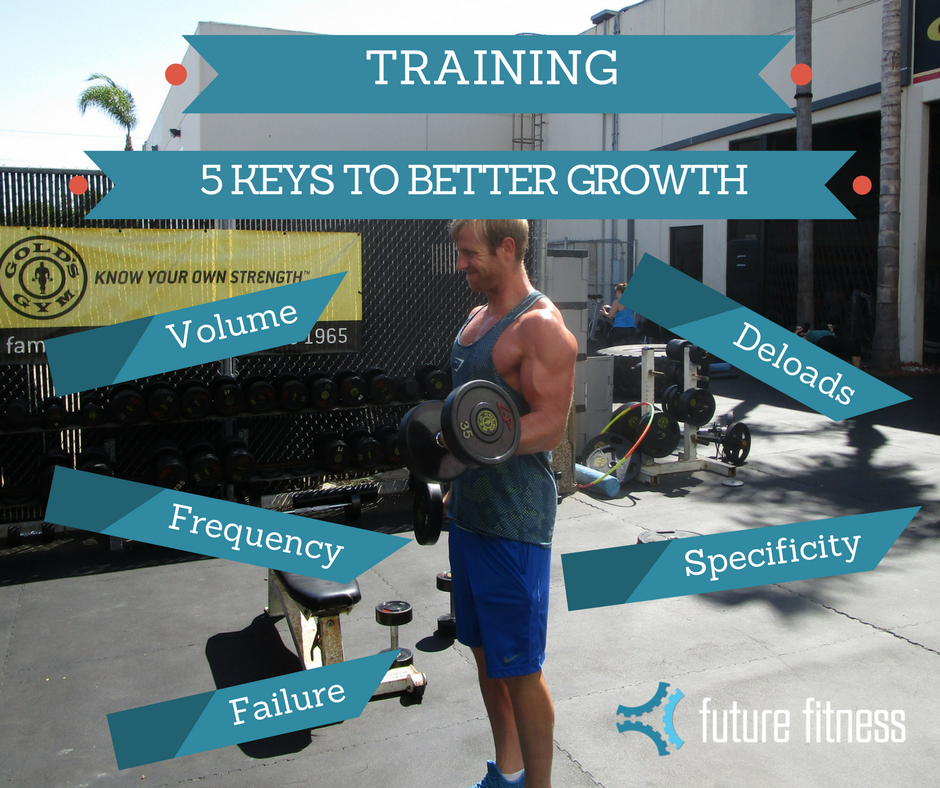For the last 8 years I have been searching high and low for any valuable information that could help me gain some extra muscle.
As a trainer in the fitness industry, I’ve witnessed people using below par training approaches for a long time now. This has led me to write this article.
Instead of looking for that one magical program which will unlock all these gains, we need to look a bit deeper and look at the underlying principles that any successful program has.
What you need to know:
- Volume is a key driver of muscle growth.
- A higher training frequency can be better for muscle growth.
- Deloads are a necessary part of a training program.
- You need to be specific with your training.
- Consistently training to failure is not the best option.
Let’s dive into these a little further…
1. VOLUME

Volume is the total amount of work done.
It’s calculated as weight x sets x reps. this is called volume load.

You can see from the program above with the Incline Bench press;
Weight (32.5) x Reps (6) x Sets (1) = 195kgs of total volume for the set.
Volume can also be looked at in terms of reps. which is shown as reps x sets.
E.g. 4 sets x 10 reps = 40 total reps
Volume is key for muscle growth.
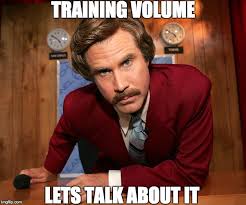
Studies have shown us that increasing volume over time is one of the prime drivers of hypertrophy. This is the reason why we don’t just do one set of an exercise, we do multiple sets to increase the total volume.
So if you stopped reading now you might just think all you need to do is keep on adding sets to your exercises and keep increasing volume.
Not so fast!
DOING MORE IS NOT ALWAYS BETTER!!
I REPEAT
DOING MORE IS NOT ALWAYS BETTER!!
Increasing volume is needed for muscle growth but only up to a certain point, once you go beyond this point it will have a negative effect because you won’t be able to recover from that volume.
Think of it like your job.
You usually do an 8 hour work day. No problem.
You start doing 12 hour shifts. It’s a bit tougher but you survive it.
Then you start doing 16 hour work days. It’s too much for you and you can’t keep doing it. You can’t do your job properly because you’re so tired all the time, falling asleep in work and start to get sick from being run down.
Why? You are overworked.
Exact same thing with training, you become overtrained and are no longer able to make progress.
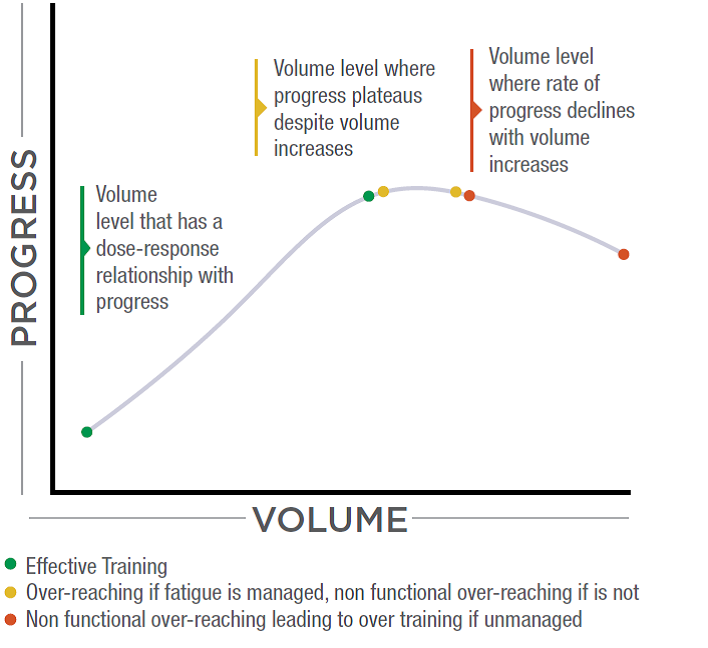
How much should I do?
This question is still up for debate in the fitness community and more research is sure to be done in the future on this topic.
There seems to be 2 popular methods;
- Do enough to progress, not as much as possible. Increase when plateaued if you are recovering well.
- Do as much as possible that you can still recover and adapt from.
Eric Helms, in the book ‘Muscle And Strength Training Pyramids’ gives a recommendation of 40-70 reps per muscle group per session. 80-210 reps per muscle group per week.
Brad Schoenfeld conducted a meta-analysis that showed 10+ weekly sets per muscle group would be a minimum to maximize muscle growth. The maximum number of sets has not been determined and would most likely depend on the individual.
Recommendations for volume
Here’s what we know;
- Volume must increase over time for muscle growth.
- 10+ weekly sets per muscle group will give a greater opportunity for muscle growth.
- You can do too much volume that will negatively effect muscle growth.
The answer lies somewhere in-between so we can use these findings above to create a program that fits in line with them. After that, we must take our own training experiences and adjust these variables to what works best for us.
2. FREQUENCY
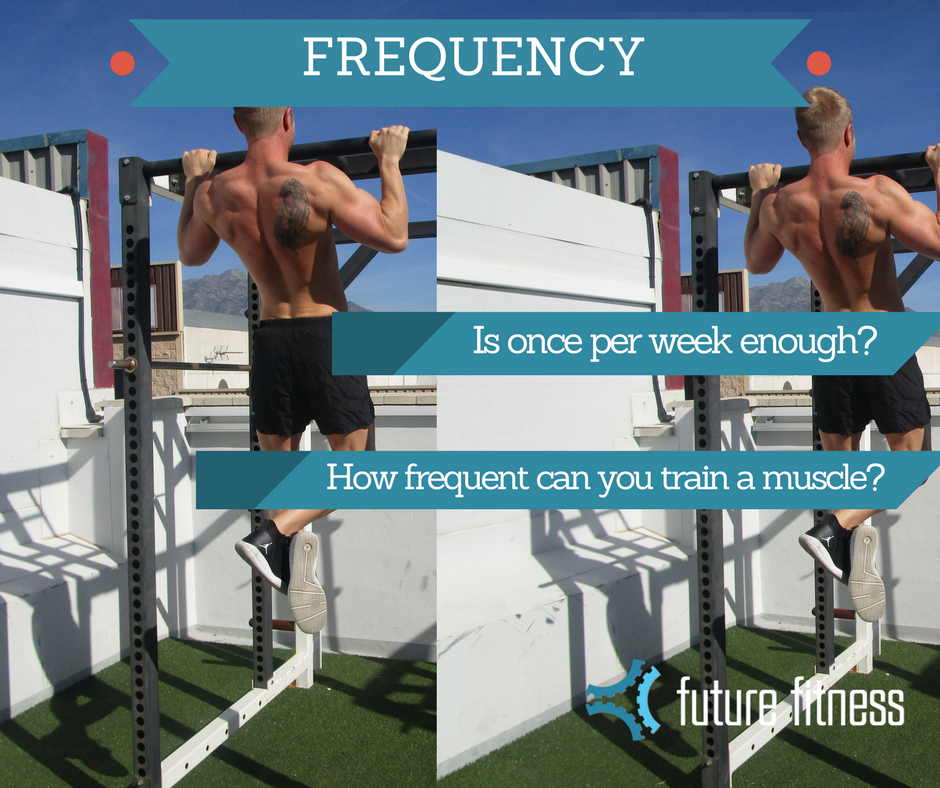
Training frequency refers to the number of sessions completed in a given period of time.
For most trainees this period of time is a week-long.
The current evidence suggests that training a muscle group 2 times per week is superior to 1 time per week.
This goes against the typical old style bodybuilding ‘bro’ split that is common among lifters today where you train each bodypart once per week on a separate day.
E.g
– Chest
– Back
– Shoulders
– Arms
– Legs

A recent meta-analysis by Schoenfeld et al concluded that:
“When comparing studies that investigated training muscle groups between 1 to 3 days per week on a volume-equated basis, the current body of evidence indicates that frequencies of training twice a week promote superior hypertrophic outcomes to once a week. It can therefore be inferred that the major muscle groups should be trained at least twice a week to maximize muscle growth; whether training a muscle group three times per week is superior to a twice-per-week protocol remains to be determined.”
From this we can say that training each bodypart twice per week minimum is superior for muscle growth.
But why is it better than one?
Increasing your frequency will allow you to accumulate more total volume over time.
Example
You do 10 sets of Bench Press on a Monday
5 sets 10 reps @ 100kg = 5,000kgs of volume
Start to get fatigued
Remaining 5 sets 10 reps @ 90kg = 4,500kgs of volume
Total weekly volume = 9,500kgs lifted.

Instead
Monday
5 sets 10 reps @ 100kg = 5,000kgs of volume
And you recover and come back Thursday and do
5 sets 10 reps @ 100kg = 5,000kgs of volume
Total weekly volume = 10,000kgs lifted
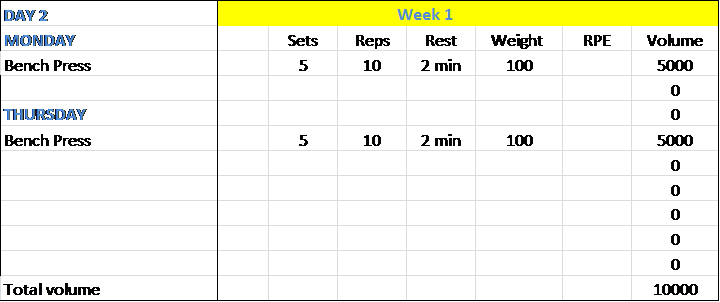
By splitting up your volume and increasing your frequency you were able to accumulate an extra 500kgs of volume in the week.
You do this every week for 12 weeks.
9,500 x 12 weeks = 114,000
10,000 x 12 weeks = 120,000
500 x 12 = 6,000kgs extra volume by increasing your frequency.
From above, we know how important volume is for growth. Who is going to have more chance of growing more muscle???
The guy who lifted 114,000kgs over 12 weeks?
or
The guy with the higher frequency who lifted 120,000kgs over 12 weeks?
The guy with the higher frequency.
Another reason why a higher frequency is better is due to the elevated levels of muscle protein synthesis. (MPS)
Studies have shown when you train a particular bodypart you will experience an elevated level of MPS that lasts typically for 24-48 hours. (1 to 2 days) This means you will only repair and build muscle for that 24-48 hours.
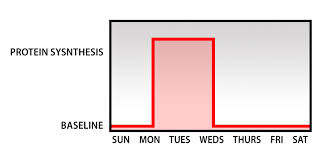
If you are only training a muscle group once per week you will have another 5 days where MPS will not be elevated. No repair or growth will be happening.
If you train that muscle group again in 2-4 days you will have a much shorter period where MPS will be at baseline. This technically means by training that muscle group more often you will be giving it more chance to repair and grow.

It’s important to remember that if you take anabolic steroids your level of MPS is elevated all the time. This might be why you see so many people still using the traditional bro splits training bodyparts once per week and getting the results you see.
Recommendations for frequency
2-3 times per week frequency for bodyparts depending on the amount you train.
If you are currently training a muscle group once per week, it’s important to not take away from this that you should just double the amount of work you are doing. E.g. Go from training chest once per week doing 15 sets to twice per week doing 30 sets total. This would be too much volume. Instead just take that 15 sets and split it into 2 sessions doing 8 sets one day and 7 the next. This is a much more practical option.
3. DELOADS

What are they?
A deload is a planned reduction in training intensity through a reduction in load (weight lifted) and/or training volume (sets).
It’s a way of allowing the body to recover and avoiding overtraining.
As you get more experienced in the gym it becomes more and more important.
Why use them?
When you are training intensely and pushing yourself hard enough to make progress you are forcing your body to adapt which is putting stress on the body, if you just keep doing this without ever backing off you are just going to end up overtraining and become run down, less motivated, increased injury risk and a lot of times weaker because you aren’t recovered.
Putting these deload weeks into your program stops that from happening and can allow you to continue to make progress.
Fatigue will often mask progress.
Once you reduce fatigue you will see where you have made progress.
There’s a few different ways to deload and how often depends on the situation;
– Training program
– Goals
– Training experience
– Fatigue management
– Individuals response to training volume
Recommendations for deloads
Cutting: Every 4-5 weeks
Bulking: Every 4-8 weeks
How to deload?
– Reduce the amount of sets per week you are doing.
– Reduce the weight being lifted on exercises
– Reduce the amount of days you are training
– Take time off the gym
If you are training with a structured program with progression principles in place you will be glad to deload.
If you aren’t taking deloads, either one of two things are happening;
- You’re not training hard enough to need to deload.
- You’re overtraining and missing out on the opportunity to make more progress.
As I heard Dr Mike Isratel say lately “If you are training hard enough and not taking deloads, your body will force you to deload when your pec rips off the bone!”

4. SPECIFICITY

This refers to directing your training towards a specific goal and making sure that you are training in a manner that is specific to achieving that goal.
We are all guilty of wanting it all;
We want to build muscle but lose fat at the same time.
(I’ve wrote an article on this topic, which you can find linked below)
https://www.mcfuturefitness.com/can-you-gain-muscle-and-lose-fat-at-the-same-time/
We want to get really strong but also really big at the same time.
The problem with this is that by trying to achieve everything at once we compromise ourselves by not getting the full benefit from anything.
If you want to get as strong as you can, you need to train specifically to get strong.
If you want to build as much muscle as you can, you need to train specifically for muscle growth.
So if you’re looking to improve your 1 rep max on Bench press doing 5 sets of 12 reps is not optimal for you. It’s not specific to your goal.
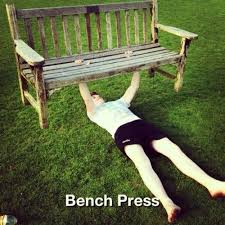
If you want to build muscle and you’re hitting a 1 rep max Bench press every week it’s not optimal for muscle growth. Lifting this heavy is very fatiguing and will effect your ability to recover and you won’t be able to get in as much total volume. (Which we know is key for growth.)
Brad Schoenfeld’s study demonstrates this
2 groups
Volume was matched
1 group performed 3 sets 10 reps
1 group performed 10 sets 3 reps
Results found equal amount of muscle growth in both groups and the 3 rep group got stronger.
BUT
3 rep group experienced;
– More dropouts due to injury
– More joint pain
– Regularly felt beat up and tired
– Took way longer to complete the workouts (like hours longer)
So if your goal was to build muscle would you rather do 3 sets of 10 reps that would take you only a few minutes to complete or do 10 sets of 3 reps and be in the gym for hours, feel beat up and wrecked. Easy answer!!
BE SPECIFIC, BE EFFICIENT
Reccommendations for muscle growth
60-75% of your volume should be in the 6-12 rep range.
Rest of your volume should be in the 1-6 rep range or 12+ rep range.
Reccommendations for strength
60-75% of your volume should be in the 1-6 rep range.
Rest of your volume should be in the 6-12 rep range.
5. FAILURE

Training to failure is one of the biggest mistakes I see in the gym.
“Go hard or go home”
“One more, one more”

These types of gym motivation make people think they need to absolutely smash themselves into the ground to make progress. Unfortunately for them, by doing this it can actually have the opposite effect.
There are 2 types of failure;
- Muscular Failure. When you go to muscular failure and if you were to do anymore you would break form. You could probably do a couple of more reps with poor form.
- Mechanical Failure. You can’t physically lift the weight anymore.
Why you shouldn’t go to failure… (very often)
Going to failure will have a negative impact on the amount of volume you will be able to do in further sets and exercises in that workout.
EXAMPLE
You do 3 sets of Bench press with 100kg
Set 1 = 6 reps (fail on 7th)
Set 2 = 3 reps
Set 3 = 3 reps
Total = 12 reps.
If you were to have just done 5 on the first set and not went to failure you would have been able to do 3 sets of 5 reps
Set 1 = 5 reps
Set 2 = 5 reps
Set 3 = 5 reps
Total = 15 reps
Going to failure effects your ability to recover and can have effects on your sessions in the following days. It also increases the risk of injury.
Recommendations for failure
Failure needs to be planned and used sparingly, if at all.
For compound exercises like Squats, Deadlifts, Presses and rows I wouldn’t recommend going to failure unless it’s a 1 rep max or for an AMRAP test. Regularly going to failure on these movements will have an effect on your recovery and volume.
For isolation exercises like lateral raises, leg extensions, bicep curls and tricep pushdowns you can go closer to failure and use failure a bit more as it doesn’t have as much of an effect on recovery.
If you made it this far I hope that you can see how the above 5 principles are all related to each other and can have a knock on effect.
By incorporating these principles into your program you will take your training to the next level.
If you enjoyed this please feel free to share with a friend or anyone you think can benefit from it.
Coach
Matt
References
http://www.lookgreatnaked.com/blog/how-many-sets-do-you-need-to-perform-to-maximize-muscle-gains/
Helms 2015, Muscleandstrengthtrainingpyramids
Ready to Begin Your Transformation Journey?
Join our online coaching programme


